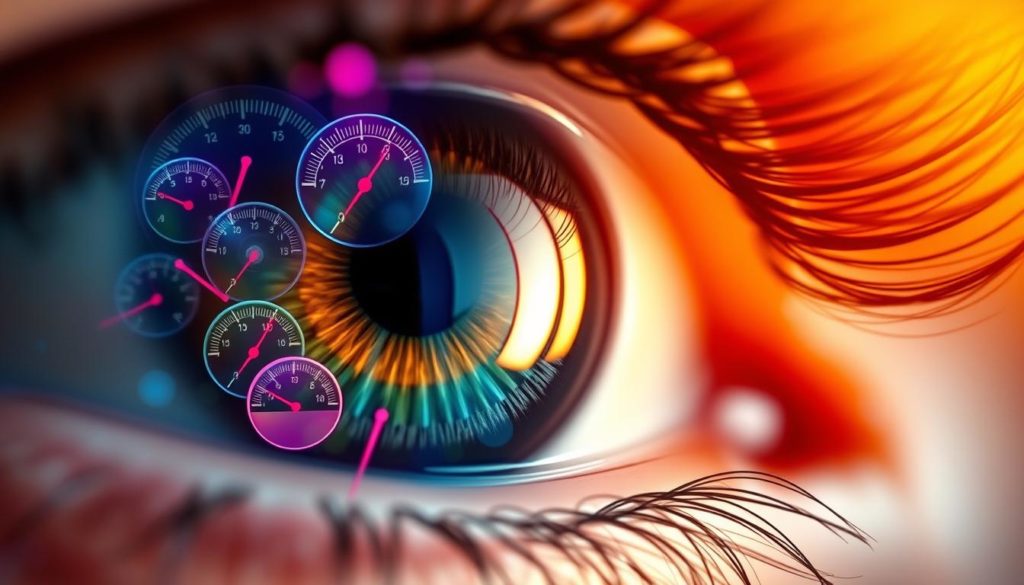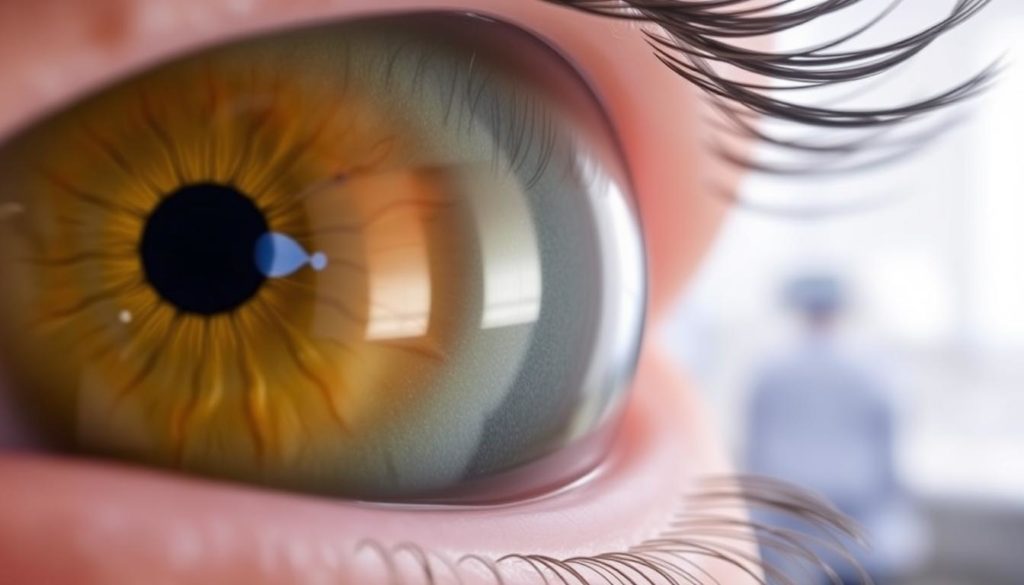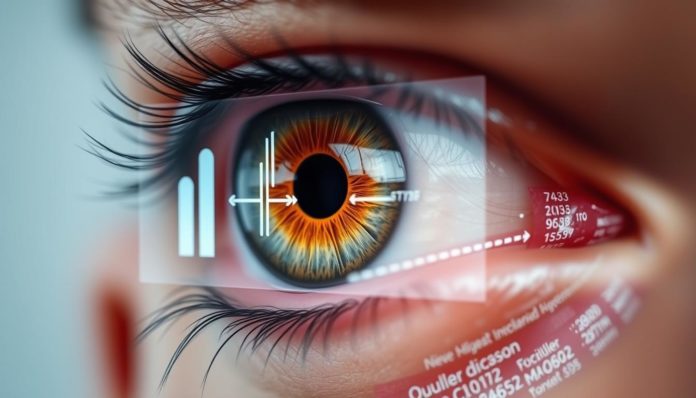“The eyes are the windows to the soul.” – William Shakespeare. This quote highlights the importance of eye health. It’s crucial for our vision and overall well-being. Ocular hypertension, with higher-than-normal eye pressure, often goes unnoticed until it’s a big risk to our sight.
Understanding and managing ocular hypertension early can prevent serious problems like glaucoma. Glaucoma is a leading cause of blindness. This article will cover the basics of ocular hypertension. We’ll look at symptoms, treatment options, and ways to prevent it to protect your eye health.
Understanding Ocular Hypertension
Ocular hypertension is when the eye’s pressure goes up. It’s different from other eye problems because it doesn’t hurt the optic nerve right away. But, it’s still important to watch it because high pressure can lead to bigger issues.

What is Ocular Hypertension?
Ocular hypertension happens when the eye’s pressure gets too high. It’s measured in millimeters of mercury (mmHg). Normal pressure is between 10 and 21 mmHg. If the pressure is high but there are no symptoms, it’s called ocular hypertension. It’s important to check it often because it can lead to other eye problems.
How it Differs from Glaucoma
Many people mix up ocular hypertension with glaucoma. But they’re not the same. Glaucoma is when high pressure damages the optic nerve and causes vision loss. Ocular hypertension doesn’t always lead to glaucoma. But, having high pressure increases the risk of getting glaucoma.
Signs of Ocular Hypertension
Ocular hypertension often shows little to no symptoms. This makes it important to watch for any vision or eye health changes. Catching it early can stop it from becoming a bigger eye disease problem.
Common Symptoms
Many people don’t notice symptoms of ocular hypertension. But, some signs can point to a problem. These include:
- Mild headaches
- disturbances
- Eye strain

When to See a Doctor
Getting regular eye exams is key to catching ocular hypertension early. If you see vision changes, see an eye doctor. Sudden severe eye pain, red-eye, or sudden vision changes need immediate eye doctor visits. These could be signs of a serious issue.
Risk Factors for Ocular Hypertension
Knowing the risk factors for ocular hypertension is key to keeping your eyes healthy. These factors can greatly affect your chance of getting the condition.
Genetic Predisposition
Family history is a big deal for ocular hypertension. If your relatives have had high eye pressure or eye problems, you might be at higher risk. Genes play a big role in this condition. So, it’s important to watch your eye health closely.
Lifestyle and Environmental Factors
Many lifestyle and environmental factors can raise your risk of ocular hypertension. Using corticosteroids for a long time can increase eye pressure. Also, having high blood pressure or diabetes can up your risk. Your ethnicity can also affect your risk.
Knowing these factors helps you manage your risks better. Here’s a quick summary:
| Aspect | Details |
|---|---|
| Family History | Certain genetic markers and hereditary aspects |
| Prolonged Corticosteroid Use | Usage in any form can contribute to elevated intraocular pressure |
| High Blood Pressure | Increases the risk due to its effect on overall vascular health |
| Diabetes | Can complicate eye health, contributing to the risk of ocular hypertension |
| Ethnicity | Some ethnic groups have a higher predisposition to this condition |
Ocular Hypertension Management
Managing ocular hypertension is key to keeping your eyes healthy for a long time. It helps prevent serious problems like glaucoma. A big part of this is keeping an eye on intraocular pressure regularly. This lets doctors catch any big changes early and act fast.
Taking your eye drops as directed is very important. Doctors often prescribe these because they help keep the pressure in your eyes just right. This is crucial for avoiding damage to your nerves.
Changing your lifestyle is also important. Here are some ways to help your eyes:
- Eat foods that are good for your eyes
- Stay active with regular exercise
- Don’t smoke and cut down on alcohol
- Watch how much caffeine you drink, as it can raise eye pressure
By following these tips, you can manage ocular hypertension well. This helps keep your vision sharp and healthy.
If you want to see how different ways to manage ocular hypertension compare, check out the table below:
| Strategy | Benefits | Challenges |
|---|---|---|
| Intraocular Pressure Monitoring | Early detection of changes, timely intervention | Requires regular check-ups, potential cost |
| Eye Drops | Reduce intraocular pressure, prevent nerve damage | Possible side effects, adherence difficulties |
| Lifestyle Adjustments | Supports overall eye health, non-invasive | Consistency required, gradual impact |
Ocular Hypertension Treatment Options
It’s important to know the different ways to treat ocular hypertension. This helps manage the risk of glaucoma. Patients have many options to lower eye pressure, from medicines to surgery.
Medications
Glaucoma medications are a key treatment for ocular hypertension. These include:
- Prostaglandin analogs
- Beta-blockers
- Alpha agonists
- Carbonic anhydrase inhibitors
Prostaglandin analogs are often the first choice because they work well. Beta-blockers help by reducing fluid in the eye. It’s best to talk to an eye doctor to find the right medicine.
Surgical Procedures
If medicines don’t work, surgery might be needed. Some options are:
- Laser therapy: Laser trabeculoplasty helps fluid drain better, lowering pressure.
- Trabeculectomy: This surgery creates a new way for fluid to drain, reducing pressure.
- Minimally invasive glaucoma surgery (MIGS): MIGS improves natural drainage with less risk.
Choosing the right surgery depends on many things. This includes how bad the ocular hypertension is, the patient’s health, and what treatments they’ve tried before. Talking to a specialist helps make a choice that fits the patient’s needs and life.
Ocular Hypertension Prevention Tips
Keeping your eyes healthy is key to avoiding serious eye problems. By taking care of your eyes, you can lower the chance of getting ocular hypertension. This helps keep your vision sharp and clear.
Regular Eye Check-ups
Seeing an eye doctor regularly is a must. They can spot early signs of high eye pressure. This early catch can lead to quick treatment and help prevent worse eye issues.
- Annual eye exams for adults, or more frequently if you’re at risk.
- Specialized tests to measure intraocular pressure and monitor eye health.
- Professional advice on maintaining and improving visual health.
Healthy Lifestyle Choices
Living a healthy lifestyle is great for your eyes. Activities like exercise, eating right, and not smoking are all good. They help keep your eyes in top shape.
- Physical activity: Regular exercise can help maintain healthy blood flow to the eyes and lower pressure.
- A nutritious diet rich in fruits, vegetables, and omega-3 fatty acids supports overall visual health.
- Avoiding smoking and reducing alcohol intake can also help protect your eyes from damage.
| Lifestyle Choice | Impact on Eye Health |
|---|---|
| Regular Eye Screenings | Early detection of potential issues, tailored advice from professionals. |
| Physical Activity | Improved blood flow to the eyes, reduced intraocular pressure. |
| Balanced Diet | Provides essential nutrients to support visual health. |
Impact of Diet on Ocular Hypertension
Eating a nutritious diet is key to managing ocular hypertension. Adding eye-friendly foods to your meals can boost eye health. This might also lower the risk of high eye pressure.
Antioxidant-rich foods like leafy greens, berries, and nuts are great. They fight oxidative stress, which can lead to eye diseases. Spinach, kale, and collard greens are full of antioxidants that help your eyes.
Fish with lots of omega-3 fatty acids, like salmon, mackerel, and sardines, are also good. Omega-3s help keep your eyes healthy by reducing inflammation and possibly lowering eye pressure.
But, watch out for foods that might hurt your eye health. Avoid processed foods, sugary snacks, and too much caffeine. They can harm your eyes and should be eaten less often.
Here’s a comparison to show how different foods affect your eyes:
| Food Type | Beneficial or Detrimental | Key Nutrients |
|---|---|---|
| Leafy Greens | Beneficial | Antioxidants |
| Fatty Fish | Beneficial | Omega-3 Fatty Acids |
| Processed Foods | Detrimental | High Sugar |
| Sugary Snacks | Detrimental | High Sugar |
| Caffeine | Detrimental (in large amounts) | Stimulant |
In short, a balanced diet rich in eye-friendly foods is crucial for managing ocular hypertension. Eating foods packed with antioxidants and omega-3 fatty acids helps keep your eyes healthy.
The Role of Stress in Eye Health
Stress can greatly affect our eye health. It can change things like intraocular pressure. Knowing how stress and vision are connected is key to keeping our eyes healthy.
How Stress Affects Intraocular Pressure
High stress can raise intraocular pressure. This is a big deal for conditions like ocular hypertension. Stress makes our body release cortisol, which can mess with eye fluid balance, causing pressure to go up.
Stress Management Techniques
It’s important to manage stress to keep our eyes healthy. Here are some relaxation techniques to help:
- Meditation: Regular meditation can calm your mind and lower stress a lot.
- Yoga: Yoga not only relaxes you but also boosts your physical health.
- Deep Breathing Exercises: Adding deep breathing to your day can cut down anxiety and help blood flow, which is good for stress management.
Using these relaxation techniques daily can help manage stress. This supports both your mental and eye health.
Latest Research on Ocular Hypertension
Recent studies on ocular hypertension have given us new insights. They are changing how we treat this eye condition. Researchers have found new signs that can predict when ocular hypertension will start.
One big medical advancement is the creation of non-invasive imaging methods. These tools help track how ocular hypertension changes and check if treatments work. The use of optical coherence tomography (OCT) and other advanced imaging has greatly helped eye disease research.
Pharmaceutical research is also moving forward. New drugs to lower eye pressure are being tested in trials. These new treatments could help patients who don’t get better with current options.
“The latest therapies in development aim to target specific pathways involved in the regulation of intraocular pressure,” said Dr. Jane Smith, an ophthalmologist involved in current clinical trials.
The table below shows important findings from recent research and trials on ocular hypertension:
| Research Focus | Findings | Potential Impact |
|---|---|---|
| Biomarker Identification | New biomarkers for early detection | Enhanced predictive power and prevention |
| Non-Invasive Imaging | Improved OCT techniques | Better monitoring and treatment evaluation |
| Pharmaceutical Advances | Novel drugs in clinical trials | More effective treatments for non-responders |
By watching the latest studies on ocular hypertension, doctors can use new knowledge in their work. This research is key to finding better treatments and helping patients with ocular hypertension.
Living with Ocular Hypertension
Living with ocular hypertension means using good vision care and support every day. Knowing about the condition and how to deal with it can make life better. It helps those who have it live well.
Managing ocular hypertension starts with regular eye exams. These check-ups help keep an eye on pressure and adjust treatments. Early action can stop ocular hypertension from turning into glaucoma.
Good vision care is also key. Eating well, staying active, and avoiding things that raise eye pressure are good steps. These actions help keep eyes healthy.
Here are some daily tips:
- Take eye drops as directed to keep eye pressure right.
- Know the signs that need quick doctor visits.
- Try stress-reducing activities like mindfulness and meditation. They can help eye health.
Patient support is crucial for dealing with ocular hypertension. Having access to info and support groups helps a lot. Talking to others who understand can offer great advice and support.
Using these vision care tips and coping strategies can make life easier. Regular talks with doctors and being proactive with support help manage the condition well. This way, patients can live confidently with ocular hypertension.
Conclusion: Embracing a Proactive Approach to Ocular Health
In today’s fast world, eye health is more crucial than ever. Ocular hypertension is a silent danger that needs our focus. Knowing about it and its differences from glaucoma helps us fight it better.
Regular eye exams and watching for ocular hypertension signs are key. These steps help keep your vision sharp.
Adding healthy habits like a good diet and stress management to your life helps a lot. Working together, we can spread the word about ocular hypertension. New research and treatments give us the tools to fight this condition.
Proactive eye care is the way to manage ocular hypertension well. Stay updated, be proactive, and care for your eyes. Your vision is precious, and with the right steps, it will stay clear and bright for years.
FAQ
What is Ocular Hypertension?
Ocular hypertension means your eye pressure is higher than normal. But, it doesn’t hurt your optic nerve or your vision yet. It’s a warning sign that could turn into glaucoma if not treated.
How does Ocular Hypertension differ from Glaucoma?
Ocular hypertension means your eye pressure is up, but your optic nerve is still safe. Glaucoma, on the other hand, damages your optic nerve because of high pressure. Not everyone with high eye pressure will get glaucoma.
What are the common symptoms of Ocular Hypertension?
Many people with ocular hypertension don’t feel any symptoms. But, some might get headaches or see things differently. It’s important to get your eyes checked often to catch any changes.
When should I see a doctor for Ocular Hypertension?
You should see an eye doctor for regular check-ups. If you have sudden eye pain, a red eye, or vision changes, see a doctor right away.
What are the risk factors for developing Ocular Hypertension?
Risk factors include your family history and genetics. Other risks are long-term use of steroids, high blood pressure, diabetes, your ethnicity, and how thick your cornea is.
How can Ocular Hypertension be managed?
Managing it means watching your eye pressure closely. You might need eye drops or make lifestyle changes to keep your eyes healthy.
What treatments are available for Ocular Hypertension?
Treatments include eye drops and surgery. Surgery like laser therapy or trabeculectomy can help lower pressure and prevent glaucoma.
How can I prevent Ocular Hypertension?
Prevent it by getting regular eye exams and eating well. Stay active and avoid things that might raise your eye pressure.
Can diet impact Ocular Hypertension?
Yes, eating foods good for your eyes can help. Eat leafy greens, omega-3 rich fish, and foods with antioxidants. Avoid foods that might raise your eye pressure.
How does stress affect eye health?
Stress can make your eye pressure go up and down. Try to manage stress with meditation, yoga, or deep breathing to keep your eyes healthy.
What does the latest research say about Ocular Hypertension?
New research is looking at better treatments and understanding ocular hypertension. Keep up with the latest to help manage your condition.
How can I live with Ocular Hypertension?
Living with it means taking care of your vision every day. Stay informed, get support, and follow your treatment plan to manage it well.


